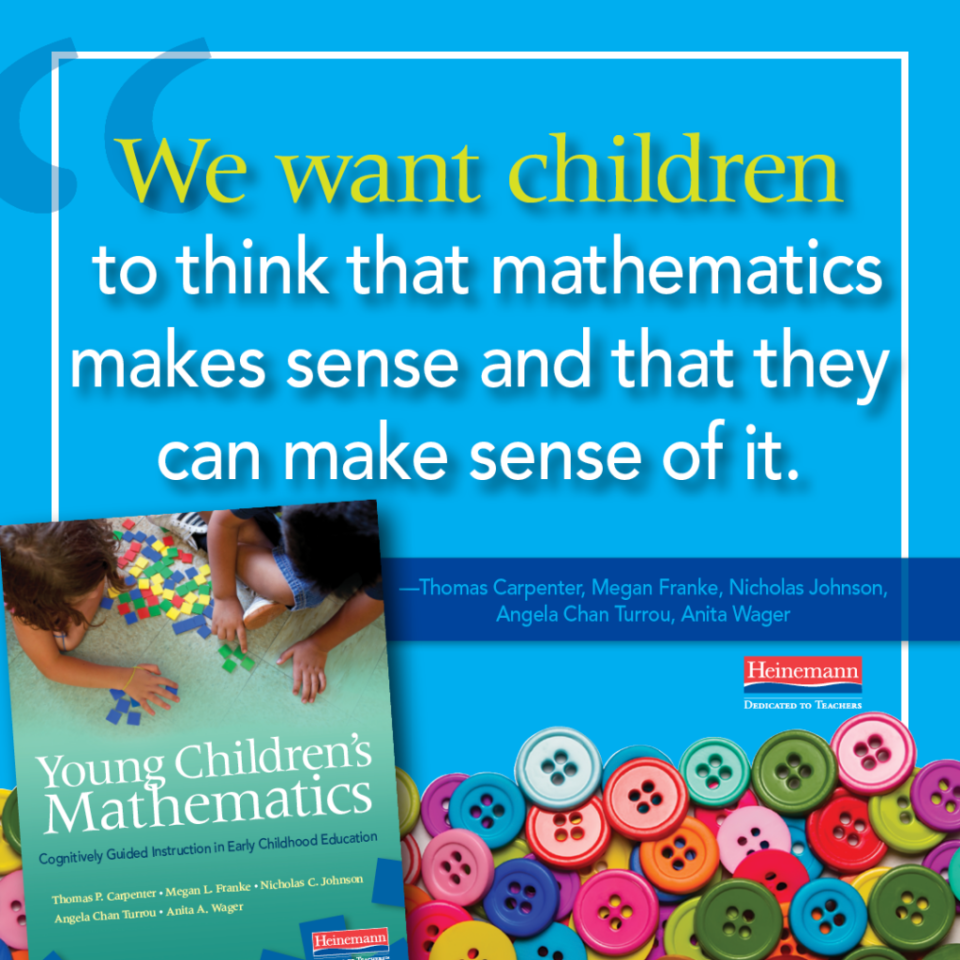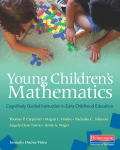
The following post is adapted from the newest book in the Cognitively Guided Instruction family: Young Children's Mathematics: Cognitively Guided Instruction in Early Childhood Education.
Supporting the Development of Counting
By Thomas Carpenter, Megan Franke, Nicholas Johnson, Angela Chan Turrou, and Anita Wager
When thinking about how children’s counting develops, there are four big ideas to keep in mind:
- Details matter when we look for what students know about counting.
- Students can have more counting understanding than we see in a given moment.
- Counting principles do not emerge in a set sequence.
- Counting principles emerge concurrently
No matter where children are in their understanding, they can extend their emerging understandings by counting collections of objects. When engaging in counting, a child may not yet draw on all of the principles and may not arrive at a correct total, but the details of what they do will show you that they have some knowledge of how to count. Watching and listening to children’s counting will help you see what a child knows and what they still need to learn.
Seeing how children develop counting principles in different ways has significant implications for instruction. First, we can ask all children to count collections even if they don’t yet know the counting sequence. Second, observing a child’s counting and asking questions about what the child did can provide important insights. Third, there are benefits to counting collections greater than 5, 10, or even 20. Finally, the materials we ask children to count may influence their counting.
These four key implications lead to other important ideas and strategies to remember as you support children learning to count:
You don’t have to wait to have children count collections until they are proficient at reciting the counting sequence.
Children develop understanding of counting as they count collections because counting a collection gives them an opportunity to use each of the counting principles. Counting a collection can create a need for the child to extend their counting sequence beyond where they may be comfortable. While we may hesitate to ask children to count collections when they do not yet have the correct number sequence because we are worried they are using the “wrong” numbers, we see these invented sequences as productive and a normal part of learning. Counting collections does not hamper children’s use or learning of the counting sequence; rather, it is through counting the objects that children continue to build their understanding of the number sequence while coordinating the sequence with the other counting principles.
Observe and ask questions.
It is striking how little we know about children’s understanding of counting by just hearing the answer to “How many are there?” A child may respond “8” to a collection of 8 bears, but you need to know how the child got 8. Finding out what children know about counting requires watching and listening as they count, touch, organize and reorganize, stop and start, and complete their count. It may also require asking them, “I can see you counted your collection. Can you count it again so I can watch and listen?” In counting again not only do you get a chance to see specifically what the child is doing and saying, but the child also gets a chance to work through it again. Our challenge as teachers is to take a moment to observe and listen and not intervene too soon.
It can be productive to have children count larger collections.
Our research shows benefits to counting larger collections. Larger collections would be ones that go beyond our typical expectations and often beyond what we think children know about counting. School mathematics often sequences the range of children’s counting: counting to 3 then to 4 and then to 5, counting 10, and so on. Asking children to count larger collections creates space for them to work on acquiring the principles and gives the teacher a chance to see a broader picture of what the child knows about counting.
Have children count different materials.
Counting different materials (pennies versus bears, for example) can influence a child’s use of the counting principles. So, if a child seems to be struggling to count a collection, it might help to consider a different type of object to count. For example, a preschool teacher was concerned that one of her students was struggling with counting and did not know the counting sequence beyond 5. During a home visit she learned that the family placed very high value on science and that the child was particularly knowledgeable about marine animals. The day after the home visit, the teacher noticed the child looking at a stuffed shark on the floor. When she asked him how many teeth his shark had, he correctly counted (using all of the counting principles) to 13. This example helps us see that what children count matters and also that what we see a child do at school may not capture all of what the child knows and understands. We need to use a range of approaches to create opportunities for children to display their competencies.
♦ ♦ ♦

Thomas Carpenter is Emeritus Professor of Curriculum and Instruction at the University of Wisconsin–Madison.
Megan Franke is Professor of Education at the University of California, Los Angeles.
Nicholas Johnson is a Doctoral Candidate in Urban Schooling at the University of California, Los Angeles.
Angela Chan Turrou is a researcher and teacher educator at the University of California, Los Angeles.
Anita Wager is Associate Professor in Curriculum and Instruction at the University of Wisconsin–Madison.


